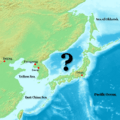Geographical renaming facts for kids
Geographical renaming is when the name of a place, like a city or a country, gets changed. This has happened many times throughout history for different reasons.
Contents
Why Do Places Change Names?
Places can change their names for several interesting reasons. Let's explore some of them.
When Countries Join Together
Sometimes, countries decide to join up and become one bigger country. When this happens, the name of the new country might change. For example, in 1707, the Kingdom of England and the Kingdom of Scotland joined to form the United Kingdom. Later, in 1801, Ireland also joined. This made the country's name the United Kingdom of Great Britain and Ireland.
When Countries Split Apart
Just like countries can join, they can also split into new ones. This often leads to name changes for the new countries. A good example is Czechoslovakia. In 1992, it split peacefully into two new countries: the Czech Republic and Slovakia. Another example is when Ireland became independent from Great Britain. The part called Northern Ireland chose to stay with the United Kingdom. So, the country's name changed from the United Kingdom of Great Britain and Ireland to its current name, the United Kingdom of Great Britain and Northern Ireland.
New Governments and Leaders
When a new government takes over, it might want to change names to show its new power or to honor important leaders. After the Communist Party took control of the Russian Empire, they changed the country's name to the Soviet Union. The famous city of Saint Petersburg was renamed Leningrad. This was to honor their leader, Vladimir Lenin. It also showed they were moving away from the old system where an emperor, called a Tsar, ruled. Saint Petersburg was originally named after Peter the Great, a Tsar who founded the city. Another example is when the city of New Amsterdam in North America, founded by Dutch settlers, was taken by the British Empire. It was renamed New York City after the Duke of York.
Returning to Original Names
Sometimes, names are changed to go back to a name used by the native people of a place, especially after a country gains independence from a colonizing power. For instance, after India became independent from Britain, the city of Bombay was renamed Mumbai. This change honored the local history and culture.
Changes in Spelling Rules
Spelling rules for a language can change over time, which can also lead to place names being updated. In mainland China, after the Communist Party of China took over, they made Pinyin the official way to write Mandarin Chinese using the Latin alphabet. This changed the spellings of many Chinese place names. For example, Peking became Beijing, and Nanking became Nanjing. Even though the way these names were spoken in Mandarin didn't change, the old spellings didn't show the correct pronunciation very well. So, people in other countries often pronounced them differently. By making Pinyin the official spelling, China wanted to help people learn the correct Mandarin pronunciation. Interestingly, in Taiwan, many people still use older spelling rules for their place names, like Taipei and Kaohsiung. This is because they don't want to use Pinyin, as it was created by the Communist Party of China.
Images for kids


